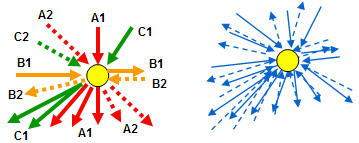Each era of civilization has been defined, constrained, and elevated by its signature form of communication: nomadic speech, agricultural writing, industrial printing, and the now-ubiquitous digital information age. Increasingly, all communications, sync and async, are passing through digital channels that mark their passage, and, often, retain all elements of an act (sender, receiver, channel-path, message). Human organizational memory has taken a huge leap in a few short decades, for better and for worse. Only appropriate realms of transparency and privacy will ensure the “better” use of our new digital power
|
|
|
Every organization link type implies a flow of information. Indeed, A reporting, B process, and C group relationships imply a D1 info flow as well as a D2 information return channel to their direction of impact, e.g., a subordinate supplies operating information to the boss, while the boss supplies decision information through the reporting-link-as-info-link
|
 |
| The actual information flows of the A-B-C links “to and fro” between 1° nodes can be mapped, e.g., analysis of email traffic between node pairs
|
 |
Organizational reality for many positions is a very large number of relatively formal and important info exchanges, many on a repeating basis. There are many info pathways between positions that can be extracted from existing information systems
|
Mining massive information links
Email traffic is captured and can be related to specific senders (from) and receivers (to), along with the message that passed between them. A pattern of communication is revealed from analyzing a flow of messages, and a pattern of topics is revealed from analyzing the messages themselves. This is data mining in an organizational context
|
| |
|
Privacy for people and small groups can be achieved by aggregating message mining across a number of positions. Boundaries of aggregation to protect privacy start at about 25, a typical 3-level organization. In smaller numbers, individual responses become increasingly easier to identify
|
|

